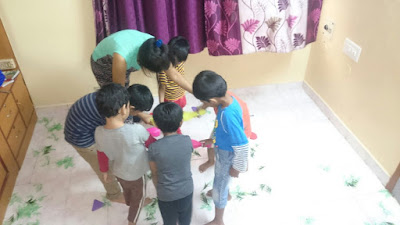Visual Perceptual Skills :
Visual Perception simply refers to the brain’s ability to make sense of what the eyes see. Now many people tend to mix up this concept with visual acuity, which refers to how clearly a person sees. But what we need to keep in mind is that irrespective of how clearly a person is able to see he or she might still have problems with visual perceptual processing. Visual perceptual skills help kids to obtain and establish visual information from the environment and try to understand what they see.
 |
| Chaitanya's Visual Perceptual Skills |
WHAT COMES UNDER THESE SKILLS?
Form Constancy:
Ability to identify a form even if it is different in size, orientation, color, or texture. This skill also helps children recognize an object in different contexts regardless of changes in size, shape, and orientation. Children with poor form-constancy may struggle to recognize objects when turned a different direction or viewed from a different angle. They would fail to recognize even the words they know if they are presented in a different manner.
Figure Ground:
Ability to distinguish a form from the surrounding background
Spatial Relations/Position in Space:
Ability to understand the position of objects in relation to each other and to oneself.
Visual Discrimination:
Ability to perceive the differences and similarities in forms
Visual Closure:
Ability to identify a form even though part of it is not visible
Visual Memory:
Ability to remember what one sees
Why should you seek therapy if you notice difficulties with visual perception?
1. To improve ability in and persistence with visual tasks.
2. To ensure a child is able to engage in academic tasks.
3. To help a child to complete self care tasks, such as putting shoes on the right feet.
4. To avoid a child becoming disengaged in an academic environment due to difficulties completing visual activities (e.g. writing, cutting, drawing).
5. To avoid frustrations experienced by parents, teachers and children when a child is struggling to remain engaged in academic activities.
6. To help maintain and develop a positive sense of well being.
7. To ensure that a child doesn’t fall behind their peers in development of skills such as handwriting, spelling and maths.
2. To ensure a child is able to engage in academic tasks.
3. To help a child to complete self care tasks, such as putting shoes on the right feet.
4. To avoid a child becoming disengaged in an academic environment due to difficulties completing visual activities (e.g. writing, cutting, drawing).
5. To avoid frustrations experienced by parents, teachers and children when a child is struggling to remain engaged in academic activities.
6. To help maintain and develop a positive sense of well being.
7. To ensure that a child doesn’t fall behind their peers in development of skills such as handwriting, spelling and maths.
Dr.GeevaKamal Raj
Chaitanya Therapy Centre
About Chaitanya Speech Therapy Centre Services in Chennai :
No comments:
Post a Comment